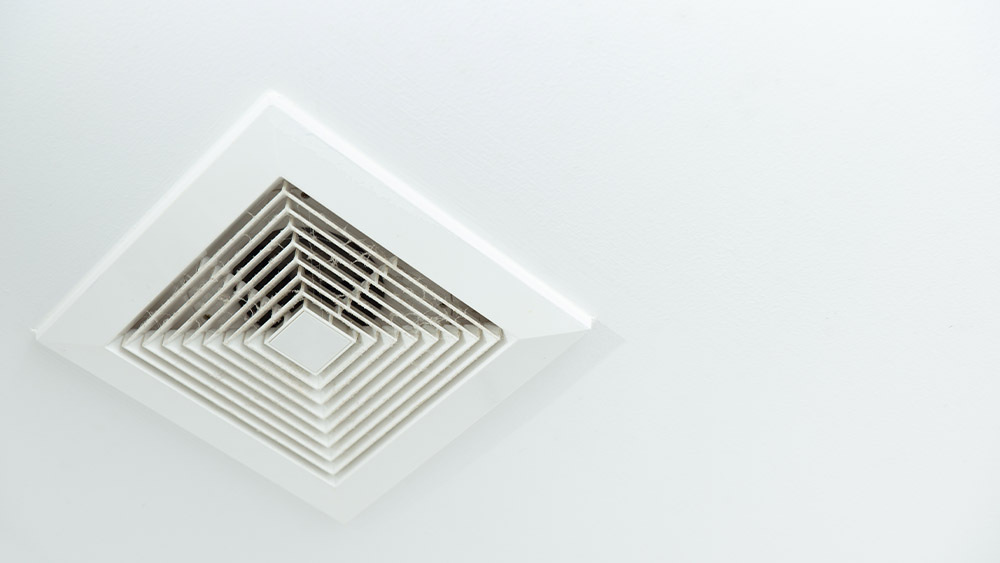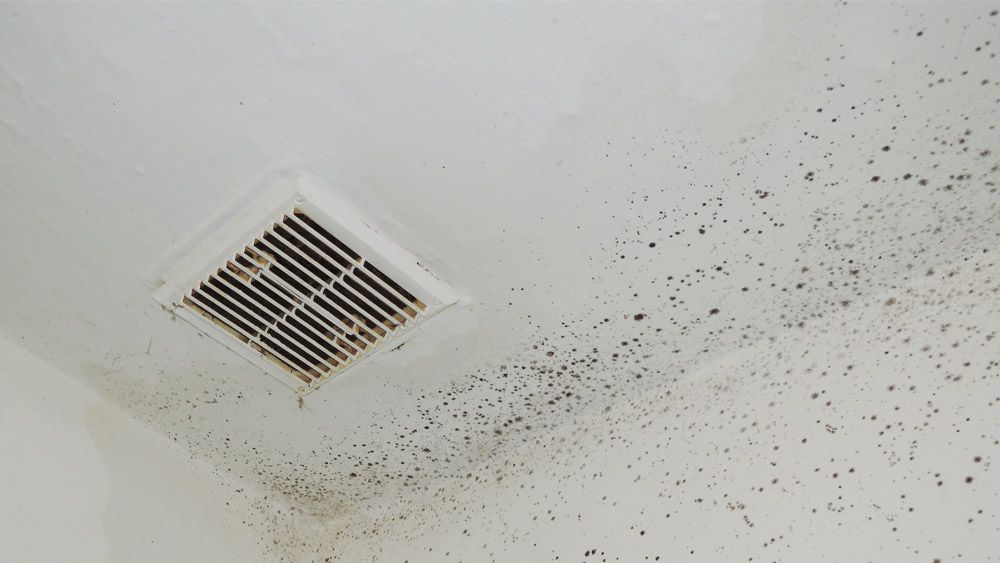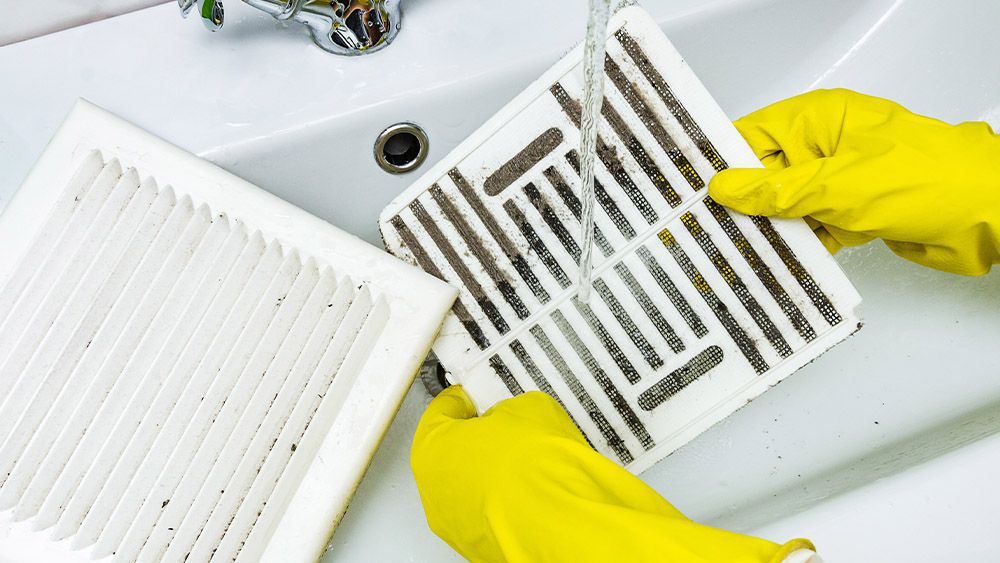What Causes Mold On Register
Mold in Air Ducts: Causes, Symptoms, Cleaning, Prevention & All That Y'all Demand To Know

Summertime can be difficult to survive without a properly functioning air conditioning organisation. Hot and humid surround drains all our energy, preventing us from functioning properly. Simply cheers to HVAC systems, we're able to make the about of this wonderful season and go going!
Unfortunately, though, increased humidity during the hot summer months tin can affect your HVAC unit of measurement. A hot and damp environment can lead to the product of mold in air ducts. Therefore, it is necessary that you offset taking precautions before you detect yourself troubled.
Let'due south take a await at what you can practise to deal with mold growth!
What Causes Mold to Grow in Air Ducts?

If the surroundings is favorable for this undesirable fungus, mold tin can grow and settle in your air ducts. Information technology can even easily spread beyond your unabridged habitation or edifice through your HVAC system.
The components of an HVAC unit comprise wet from all the dehumidification, which can lead to the production of mold in air ducts. If y'all don't maintain the humidity levels inside the ducts, it becomes a source for mold to thrive easily. Since air ducts are closed, nighttime, and don't get checked often, it only continues to abound if it's nowadays. The ducts provide a conducive environment for mold as they collect grit particles, dander, pollen, dead peel cells, etc., which go their source of nourishment.
If you own an oversized Air conditioning unit, it tin also lead to mold growth. A unit as well big for the expanse won't run much longer to dehumidify the air. Hence, leaving enough moisture for mold to grow on the metal surface of the ducts. Please read our guide to find the perfect air conditioner size for your room.
In addition to this, any leaks in your roof or the attic area can make your AC ducts moisture, providing room for mold growth. Moreover, poor ventilation in the bath causes the steam to travel into your rooms and somewhen enter the air ducts, creating a perfect environment for mold growth.
Symptoms of Mold in Air Ducts
The merely way to verify the presence of mold in air ducts is past sending a sample to a lab for a test or by checking it via a mold testing kit. However, if you're wondering how to detect mold on your own, then lookout for a few things that are early on indicators pointing out the presence of mold in AC ducts. Allow's accept a look:
1. Musty Smell
The outset thing that can signal to the presence of mold in air ducts is a musty smell. It's difficult to encounter mold at first equally the expanse inside the vents isn't very visible; therefore the footstep to detect mold growth is through bad odor. A mildew-like musty smell when your air conditioner is turned on should warning you at in one case. Since the air flows through ducts, the bad odour can also spread across all your rooms.
Fifty-fifty though a musty odor won't always lead to the presence of mold, it narrows down the crusade to mold growth.
For more information on air conditioner smells, see our commodity on why AC smells bad.
two. Blackness Dust
The presence of black dust around air conditioner vents indicates the presence of mold in ducts. This grit is extremely toxic and is not easy to wipe off. It may besides lead to the apportionment of mold spores forth with conditioned air into your rooms. Immediately contact a professional and turn your HVAC unit of measurement off to prevent information technology from spreading any further.
3. Allergy-Similar Symptoms
People who are exposed to mold spores can have adverse health-related issues. If your breathing air is infected with mold, you may suffer from headaches, nasal congestion, itchy eyes, coughing, sneezing, and skin irritation. If you're facing allergy-like symptoms when you turn your AC on and they go away when off, you should take a await inside your air ducts. The longer you lot ignore the problem, the worse your symptoms will get.
Acquire more about air conditioner allergy and how to prevent it.
iv. Visible Mold
Yous should often take a look around intake vents, ducts, and drip pans because they provide the perfect environs for mold growth. Mold flows through the air in the class of spores that are microscopic particles and you cannot see them with a naked eye. Then, when y'all see any visible signs of mold, it indicates that the infestation is serious and you lot demand to deal with it promptly. It's best that you lot contact a professional at this point who can bargain with the trouble and make sure it doesn't make its style back.
How to Remove Mold in Air Ducts?

If you suspect mold in your HVAC unit, the EPA suggests not running your Ac as it could cause the mold to spread beyond other parts of your habitation. It'due south best to deal with the problem as early on equally possible to minimize damage, health hazards, and expense.
Before starting a DIY mold cleaning project, y'all need to properly dressed. You lot should be wearing a protective mask with filters since breathing in mold can lead to several health issues. Keep wearing gloves during the cleaning process, and make sure yous don't touch an affected area with bare hands. You lot should too article of clothing a goggle to prevent mold spores from entering your eyes.
DIY Mold Cleaning Projection
To starting time off with a DIY mold cleaning projection, follow the steps below:
- Turn off your HVAC unit and make sure it'due south non getting any power from the main switch.
- Next, unscrew the grills on your air vent.
- Use a detergent or a dishwashing liquid and dissolve it into the h2o to make a cleaning solution. You can too add a spoonful of baking soda. If the surface y'all're cleaning is non-porous, you may mix one part bleach with 16 parts h2o. Soak the vent grills in the solution for 15 minutes.
- Meanwhile, use a HEPA filter vacuum and make clean the area inside the air ducts.
- Use the solution and a cloth to clean the surface of the air ducts. You may demand a mop to achieve the deeper areas inside your ducts.
- Take a scrubbing brush to scrub out whatever mold, debris, and dirt from your ducts.
- Now, take a clean, dry out cloth to dry the area within the ducts. Y'all must make sure the surface area is dried out properly and there is no moisture left inside.
- Finally, wipe the air vents grilles clean with h2o, dry them and reattach using a screwdriver.
- You lot may also choose to replace the grilles if they have been in use for too long.
- After the cleaning process, discard all cloths and brushes that came in contact with mold.
Looking for more than information? Here is a detailed Air conditioning ducts guide for cleaning and maintenance.
If the affected area is large and in that location is a huge corporeality of visible mold present, y'all should contact a professional instead of dealing with information technology yourself. Mold can be dangerous, or at times careful cleaning is required to avoid damage to your HVAC organisation.
Preventing Mold Growth in AC Ducts
If your HVAC ducts aren't suffering from mold at the moment or y'all're done cleaning and are looking for tactics to forbid information technology from ever occurring again, here is what you demand to do. Add these steps to your regular HVAC maintenance routine, and your air ducts should remain mold-free for a long time!
one. Use Good Quality Air Filters
Air filters play a vital office in keeping harmful particles from getting into your rooms. You should clean them after every ii weeks, i.due east., 250 hours of use. It is all-time to supercede them after every three months.
Read our Air conditioning filter guide to learn more.
2. Clean Drip Pans Regularly
Yous should take a look at the drip pans of your HVAC unit. H2o can collect in the drip pans and become a starting signal for mold growth. Clean them and make certain they are dry.
3. Look Out for Leaks To Prevent Molds in Air Ducts
Look out for any leaks effectually the air ducts and seal them. Whatever leaks in your attic or roof can also damage your ducts and lead to mold production. Practice not delay to ready any leakage problem in your house.
4. Maintain Indoor Humidity Levels
Since moisture is the root cause behind mold production, pay special attention to maintaining the humidity levels inside your domicile. It is recommended to go along the humidity level below 50% to forestall the growth of mold. You tin can use a dehumidifier to bring the humidity levels down.
Head to this commodity and take a look at the ideal indoor humidity chart.
five. Inspect Your Air Ducts Regularly
Since air ducts are airtight, yous don't see what'southward happening within. Hence, any development of mold there can get unnoticed. While irresolute/cleaning air filters, take a quick wait inside the air ducts to look for any signs of mold. If you notice any moisture surface area, dry it out without further ado. You can also use EPA registered mold growth inhibitor products while considering your HVAC manufacturer's guidelines. UV lights or ionization air purifiers tin also be installed to kill harmful particles inside the ducts.
Nosotros hope the prevention tips mentioned above will help yous stay away from the mold growth problem in the future.
Types of Mold in Air Ducts
Mold can be constitute in different forms and colors. If you're interested in going to the depths of your mold problem, y'all may be interested in knows the types of mold that can infest your air ducts. Post-obit are some of the common types of mold found in AC ducts:
Acremonium
It is a type of mold nowadays in white powdery form. Acremonium is generally plant in moisture and clammy areas around your air vents. It grows over months or even years.
Alternaria
Another commonly found mold strain, Alternaria, has a velvet-like texture. It is usually of green or chocolate-brown color. This type of mold needs a pregnant amount of running water through air ducts for its growth.
Aspergillus
It is ane of the hardest types of mold to bargain with because of the various forms that it can take. Aspergillus can appear in many colors, only the well-nigh mutual ones are green, white, or xanthous.
Fusarium
Fusarium commonly lives on the surfaces of walls that take been affected by condensation. It can make its way inside air ducts if the water damage to walls also affects the air ducts.
Mucor
You commonly find this mold in air conditioning units. It spreads to the air ducts and tin enter your home with the conditioned air. Mucor is a very toxic blazon of mold and you demand to bargain with it immediately.
Stachybotrys
If y'all encounter black mold in air ducts, then information technology is Stachybotrys. Even though it is easy to spot because of its black color but can go unnoticed every bit information technology forms deep inside air ducts. Information technology is very toxic and needs a proficient corporeality of wet to thrive.
Trichoderma
Trichoderma lives in air ducts considering it needs a constant supply of h2o to grow. It grows rapidly and it is in the grade of spores.
Chaetomium
Chaetomium is a chocolate-brown cotton wool-like structure. It is difficult to distinguish from other types as information technology tends to change its color over fourth dimension.
Ulocladium
It is one of the rarest types of mold to be found in air ducts. It is commonly constitute in kitchen or bathroom corners in the course of blackness layered substances. Ulocladium is also very difficult to deal with hence requires professional help.
Due to the unlike similarities and many types, mold is difficult to bargain with on your own. It is always a good move to talk to a professional person before you start to clean your air ducts.
Jan 3, 2022
What Causes Mold On Register,
Source: https://www.cielowigle.com/blog/mold-in-air-ducts/
Posted by: stewartupoessiond.blogspot.com


0 Response to "What Causes Mold On Register"
Post a Comment